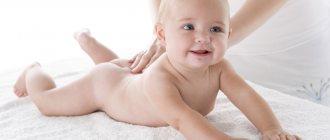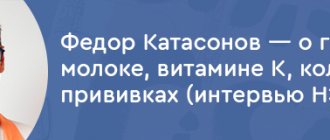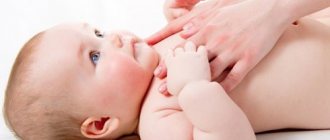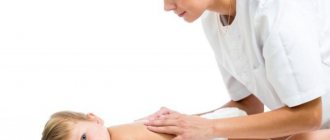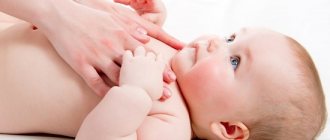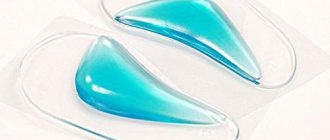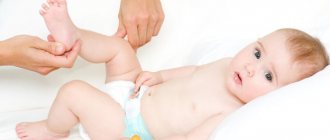Physical exercises designed specifically for newborns are recommended to be done from the first days. Such daily exercises, performed at home, will help you master the skills of grasping objects as quickly as possible, strengthen your muscles and spine, and therefore help with further crawling and taking your first steps.
Movement is the key to a baby's health.
It has long been no secret to anyone that the full intellectual and physical development of a child depends primarily on his physical activity during the first months of life.
Health-improving gymnastics classes, massage for newborns, hardening and swimming are the most important basis for the harmonious upbringing of a baby, ensuring the holistic development of the individual in the future.
Basic techniques and massage techniques for infants up to one year old
For normal development, a newborn needs massage and gymnastics, and they must be performed regularly. These activities promote physical, mental development and positive emotional contact with mom.
Include Me shortcode: file not found
In children's massage and gymnastics, all the basic techniques of classical massage and developmental exercises are used: stroking, rubbing, kneading, vibration, flexion and extension of the limbs. The technique for performing them is generally the same as for adults, but all techniques should be performed softer, with less force. At the first sessions of massage and gymnastics for children, it is allowed to use only gentle techniques (stroking), then gradually introduce the rest.
Stroking is performed before the start of each massage session and between different techniques to give the body a rest and prepare it for the next treatment. This massage technique for children is performed with the palm or the back of the hand along the lymphatic drainage pathways to the nearest lymph nodes. The lymph drainage paths are as follows: on the arms - from the hand to the shoulder (to the axillary lymph nodes), on the legs - from the foot to the groin area (to the inguinal lymph nodes), on the back - from the lumbar region to the armpits. Stroking is performed slowly, at a speed of approximately 24-26 movements per minute. Stroking is a sliding technique, so the skin should not move when performing this technique, the movements are light and smooth.
Rubbing is a more intense technique. It is performed at a speed of 60-80 movements per minute. When performing this one of the main massage techniques for a child, the movements do not have a specific direction and are performed without taking into account the lymphatic drainage paths. The purpose of this technique is to warm up the massaged area as much as possible. The impact is deeper, the skin moves. Indicators of the correctness of this technique are redness of the skin of the massaged area and the release of heat. When doing massage and gymnastics with children under one year old, rubbing is carried out with fingertips, spiral or straight movements. When massaging the limbs, ring rubbing is used. When massaging the feet, rubbing the plantar surface of the foot is performed with the pad of the thumb in spiral movements. The lower leg is massaged from the foot to the knee in a circular motion. To do this, clasp the child’s shin with both hands, placing the hands one above the other, and with the thumb and forefinger of both hands perform circular movements in mutually opposite directions, gradually rising to the knee. The thigh is rubbed towards the groin area with the pads of four fingers. When doing massage and gymnastics with babies, rubbing the hand is done in the same way. The child's chest, back and abdomen are rubbed with the pads of the thumb or the pads of two or four fingers in spiral or linear movements.
Kneading is performed taking into account the lymphatic drainage pathways. The speed of performing this baby massage technique is 40-50 movements per minute. When massaging children, forceps-like kneading or so-called felting is used.
Pincer-like kneading is carried out with three fingers of one or both hands. To do this, carefully grasp the fold of skin with the underlying muscles, opposing the thumb to the index and middle fingers, and make circular or spiral movements with the fingers, displacing the skin. The technique of massage for infants using forceps-like kneading is used for the back muscles that run along the spine, the muscles of the legs and buttocks.
The felting technique is carried out with both hands, usually on the leg muscles. During gymnastics and massage for young children, the palm of one hand is placed on the back surface of the shin, and the second hand is placed on its outer surface and the muscles are shifted between the palms, as if throwing them from one palm to the other and back. Performing such movements, gradually move from the foot to the thigh. Vibration is the final technique in a massage session. In children of the first year of life, such variations as shaking and shaking are used; after four months, light tapping with fingers can be used.
Shaking is used when massaging a baby's chest. To perform this technique, place the palms of both hands on the lower part of the baby's chest, clasping it and placing the thumbs side by side. Shaking is done with light rhythmic pressure. This massage technique for children under one year old is used for the limbs: the palms of both hands clasp the area of the limb and make the same shaking movements.
Shaking must be done very carefully. It is used for hand and foot massage. To do this, fix the child’s hand or foot with one hand, and support the knee or elbow joint with the other, respectively, and gently shake it, trying to relax the muscles of the limb. In this case, the child’s limb being massaged should be slightly bent.
Tapping is performed with one or both hands, with the back of the fingers slightly apart or clenched into a fist. Light tapping movements are performed in the longitudinal, transverse or spiral direction. Lymphatic drainage pathways are not taken into account when performing this technique.
How to massage a child: possible contraindications
There are a number of simple massage techniques for infants that a mother can perform independently every day, ensuring her baby’s harmonious physical and neuropsychic development. This restorative massage can be started for a child from 1.5 months after consultation with a pediatrician and a neurologist in the absence of contraindications.
The main contraindications for giving a massage to a child are:
- Acute febrile conditions , accompanied by an increase in body temperature. Massage promotes blood flow, which can cause the temperature to rise even more.
- Pustular, infectious-inflammatory or fungal diseases of the skin are a strict contraindication to massage, since open areas of purulent areas, as well as vesicular elements (rashes) in some infectious diseases, can be injured during massage, and the infectious agent will spread to the skin covers.
- Dermatitis, allergic reactions on the skin , which are often accompanied by the formation of oozing, which is an open wound surface. Massage, as a rule, requires the use of creams and oils, which is unacceptable on areas of affected skin. In addition, additional friction of such areas during massage can cause pain in the child and contribute to the deterioration of the local condition of the skin.
- Severe congenital heart defects with insufficient blood supply, which is manifested by shortness of breath, swelling, cough. With these diseases, signs of circulatory disorders occur in the child even at rest, and since massage is, albeit small, but still a load on the body, it will contribute to the deterioration of the baby’s general condition.
- Blood diseases (hemophilia, hemorrhagic diathesis), tendency to bleeding. Pressing on the skin during a massage can cause internal subcutaneous hemorrhages.
- Convulsive syndrome, epilepsy . In these conditions, massage is contraindicated, as it can provoke new attacks.
- Rickets during the period of exacerbation . At this stage of the disease, children are especially restless and excitable; massage as an additional stressful effect is not recommended, since a gentle regime is necessary.
- Large hernias , when internal organs (umbilical, inguinal, etc.) fall into the hernial protrusion. Massage can cause strangulation of the hernia, which will cause severe pain and may require immediate surgery.
Prematurity and malnutrition (low body weight) are not a contraindication to massage, but exercises with such babies should be delayed and must be agreed with a doctor.
Therapeutic children's massage is prescribed by a doctor to treat a particular disease and can only be performed by a qualified specialist.
The benefits of massage for a newborn baby up to one year old
Include Me shortcode: file not found
The benefits of massage for newborns are difficult to overestimate. All massage techniques help improve blood supply and nutrition to the massaged tissues. However, there are some differences in their actions. Stroking, gentle rubbing and kneading reduce muscle tone, relax, calm the nervous system; effleurage and pinching, on the contrary, increase the tone of the muscles and nervous system. In addition, rubbing and kneading have a positive effect on muscles, ligaments and tendons, strengthening them and promoting their proper development. Kneading also has a beneficial effect on the child's respiratory system. Vibration improves metabolism in the body and has some analgesic effect.
Also, the benefit of massage for a child under one year old is that all techniques help improve the baby’s well-being and health, and its harmonious development.
For massage and gymnastics for young children to be most effective, such exercises should be done in a well-ventilated room at an air temperature of 20-22 °C. You should exercise regularly, at the same time. Massage can be done no earlier than 40 minutes after feeding the baby and no later than 20-30 minutes before the next meal. The first classes should last no more than 5-6 minutes, then gradually the class time is increased to 10-15 minutes. Massage and gymnastics for infants should be carried out only when the child is in a good mood; the exercises should not cause negative emotions on his part.
During classes, you need to talk kindly to the baby, you can study to quiet melodic music.
Only a specialist with the appropriate education should engage in therapeutic massage and gymnastics with children in their first year of life.
Massage is contraindicated for any diseases and conditions of the child, accompanied by an increase in body temperature, for diseases of the heart, kidneys, lungs and blood, purulent diseases of the skin, muscles and bones.
What do you need to know?
Gymnastics for a month for a newborn Regular exercises for newborns are the key to the full development of the child’s muscles and strengthening his health.
But when carrying out it is necessary to comply with a number of requirements.
Rules for organizing a set of exercises
- A wellness massage is carried out after a meal, but at least an hour and a half should pass.
- The location (changing table) must be stable and safe for the baby.
- You should start with a few minutes, but gradually increase the time of the procedures every day.
- During the lesson, you need to talk to the baby, sing, and smile.
- Dynamic gymnastics for newborns should be carried out gently, slowly, rhythmically.
- If the baby begins to be capricious, then the classes should be stopped, since, most likely, he is already tired.
- It is necessary to start the procedures from the very first days.
Gymnastics for a month for a newborn, which is carried out at 1 month, should last at least 15 minutes. The main thing is to do it regularly so that the procedures bring only joy to the child.
How to massage newborn babies (with video)
For massage you will need a changing table (or a regular table), covered with a flannelette blanket, oilcloth and sheet or a large diaper, toys of various colors and shapes to attract the child’s attention, and for some exercises - plastic rings with a diameter of 6-15 cm and a thickness of up to 3 cm Creams and oils are not used during massage, since this will put unnecessary stress on the baby’s skin.
It is not recommended to give a therapeutic massage to a child in the first month of life, because at this time the baby’s adaptation to extrauterine life has not yet been completed, and massage will be an unnecessary burden on his body.
From the first days of a child’s life, he can and even should be caressed and stroked. This will not only strengthen the emotional bond between mother and baby, but will also have a beneficial effect on his physical and mental development. You can perform several simple exercises that will stimulate his mental development from the first weeks of life, and will also prepare the baby for massage and gymnastics at a later age.
1. When the baby is lying on his back, gently stroke the baby's cheek and he will turn towards the mother's palm. This is a manifestation of the search reflex characteristic of newborns. The exercise promotes cognitive development and also strengthens the muscles involved in turning the child’s torso from back to tummy and back.
2. With the child lying on his side or stomach, tickle his lumbar region.
Then he will lift the pelvis and bend the opposite leg. This is the so-called Talent reflex, which stimulates the muscles involved in crawling and promotes the proper development of the lumbar spine.
With your baby on his tummy, place your palms on his heels.
Then the baby will rest against them, raise his head and make several crawling movements. This is a manifestation of the crawling reflex. Exercise strengthens the muscles of the arms, legs and back, and has a beneficial effect on the brain.
Watch the video on how to massage newborns to better master the basic techniques:
Gymnastics for newborns from the first days of life
As soon as the baby turns 2 months old, add gymnastic exercises to the massage. Gymnastics for newborns from the first days of life is a special system of physical exercises that develops and strengthens the child’s joint-muscular system, promotes the development of motor functions and coordination of movements. Such activities provide a powerful stimulus for physical and mental development, give a previously unfamiliar feeling of “muscular joy,” speed up the child’s acquaintance with the world around him and make it more interesting and enjoyable. Gymnastics for newborns from the first days of life can be performed to music. The baby will love it and will help develop his sense of rhythm.
When performing gymnastics for newborns, you can use auxiliary objects: a ball, a gymnastic stick, a favorite toy.
This will add variety to your classes and cause additional positive emotions.
There are a lot of complexes of health-improving and therapeutic gymnastics that you can master with the help of a therapeutic physical education (PT) instructor.
Massage and gymnastics for newborns 1-3 months (with video)
Massage for infants begins at 1-3 months of age. It is a set of exercises that are performed in a certain sequence.
1. Stroking hand massage.
Starting position of the child: lying on his back with his feet facing the adult. The right thumb is placed in the child's right hand to stabilize it.
When performing a massage on children 1-3 months old, with your left hand you carefully stroke the child’s right arm in the direction from the hand to the shoulder, bypassing the area of the elbow joint. Then the same is done for the child’s left hand. Repeat 4-6 times for each hand.
2. Stroking foot massage.
The child is in the same starting position. His left foot is fixed in the adult's left hand. With the palm of the right hand, gently stroke the outer and back side of the baby’s left leg in the direction from the foot to the thigh. Then massage the right leg. Repeat 4-6 times for each leg.
3. Laying on the stomach.
Initial position of a newborn 1-3 months when massaging the legs: lying on his stomach, face turned to the side, hands under the chest. The baby is stroked on the back, in response to which he reflexively raises his head.
4. Back massage.
Starting position of the child: lying on his stomach with his feet facing an adult. First, stroke the child's back from the head to the buttocks with the palm of the hand and from the buttocks to the head with the back of the hand. Then lightly rub the fingertips with spiral movements. In response to rubbing, the child straightens his arms, lifting his head and upper half of his body from the surface, and looks forward. After this, gently knead with your fingertips. Repeat 4-6 times.
5. Abdominal massage.
Starting position of the child: lying on his back with his feet facing the adult. Using the palm of one or both hands, stroke the abdominal muscles up and down. Then rub in the direction from the sides to the navel. After this, circular stroking and rubbing of the abdomen is carried out with the palm of the right hand in a clockwise direction. Repeat 6-8 times.
Here you can watch the video “Massage for newborns 1-3 months”:
Massage and reflex exercises for young children 1-3 months
Gymnastics for children 1-3 months old is based on reflex exercises for the feet.
1. Starting position of the child: lying on his back with his feet facing an adult. The adult places the baby's left leg on his left wrist so that the shin is between the thumb and index finger. The right hand is placed on the child’s foot so that the thumb lies on the sole and the remaining fingers on the back of the foot. The child's fixed left foot is intensively rubbed with the thumb of the right hand in a circular motion. Then they rub and pat the back of the foot. Repeat 3-4 times. Then the right foot is massaged in the same way.
2. Make line movements along the outer edge of the baby’s foot from the fifth toe to the heel. This causes the foot to abduct outward and the toes to fan out.
3. An adult grabs the child’s foot in the area of the ankle joint with fingers II and III , and with the first finger of the same hand presses the foot at the base of the fingers. This causes the fingers to bend.
4. Along the inner edge of the foot towards the child’s fifth finger, the adult makes several stroke movements with the first finger of the hand. This movement causes the foot to flex.
5. Stimulation of the step reflex. The initial position of the child is vertical. An adult supports the baby under the arms and places his legs on the table. The child is then slightly tilted forward and he reflexively takes a few steps forward. This exercise trains the step reflex, the child begins to walk on time and more confidently.
6. Reflex crawling (disappears by three months). Starting position of the child: lying on his stomach with his feet facing an adult, legs bent at the hip and knee joints. Two palms touch the child’s feet, and he straightens his legs at the joints, actively pushing off. The exercise trains the leg muscles.
Massage and gymnastics for newborn babies 3-4 months (with photo)
1. Grasping movements with your hands.
Starting position of the child: lying on his back with his feet facing an adult. The adult places the thumbs of both hands in the baby’s palms, and with the remaining fingers grabs his wrist joints. While doing gymnastics and massage with a 3-4 month old child, an adult actively but carefully spreads the child’s arms 90ᵒ in relation to the body, and then brings them together, crossing them on the chest.
When crossing, the baby’s left and right hand should alternately be on top. This exercise helps train the muscles of the arms and shoulder girdle. Repeat 6-8 times.
2. Hand massage (see massage for a child aged 1.5 to 3 months).
Repeat 4-6 times. After some time, rubbing and kneading in the same direction are added to the stroking.
3. Foot massage (see massage for a child aged 1.5 to 3 months).
Repeat 4-8 times for each leg. Some time after stroking when performing a massage, a 3-4 month old newborn is given ring-shaped rubbing and tapping.
4. Back massage (see massage for a child aged 1.5 to 3 months).
Repeat 4-6 times.
5. Abdominal massage (see massage for a child aged 1.5 to 3 months).
Repeat 4-6 times.
6. Massage and reflex exercises for the feet (see massage for a child aged 1.5 to 3 months).
The order and frequency of execution are the same.
7. Vibration chest massage.
As you can see in the photo, when massaging the chest for babies 3-4 months old, the initial position of the child is lying on his stomach with his head towards the adult:
The adult clasps the child's chest so that the thumbs of both hands are on the baby's chest at the level of the nipples, and the remaining fingers lie along the spine. Then he makes short vibrating movements with his fingers from bottom to top. Repeat 4-6 times.
8. Turn from back to stomach.
Starting position of the child: lying on his back. The adult grabs both of the child's shins in the lower third with his left hand, with his right hand he takes the baby by the left hand and turns him over from his back to his stomach. Then the position of the hands is reversed, and the rotation is repeated in the other direction. Exercise strengthens the muscles of the back, chest and abdomen. Repeat 1-2 times.
General rules of massage for infants
In order for the massage to bring pleasure to the baby and be as effective as possible, you need to create certain conditions. The temperature in the room where the massage is performed should be comfortable for the child and be 20-22°C.
It is advisable to ventilate the room in advance, which will introduce an element of hardening into this procedure. In the warm season, massage can be performed with the window open, in the absence of drafts.
The massage should be performed on a hard, warm and non-slip surface. To do this, you can use a changing table or a regular table. It should be covered with a clean diaper, under which it is recommended to put an oilcloth and a double-folded flannelette blanket. Massage on a bed will be ineffective, since it will not be possible to create the necessary support and elasticity on a soft surface. A surface that is too hard will be uncomfortable for the baby.
It is important to choose the right time for a massage. First of all, the child must be in a good mood, well-rested and not hungry. It is recommended to start the procedure 30 minutes before feeding and no earlier than 30-45 minutes after eating, so as not to provoke regurgitation.
Before starting the massage, the mother should remove rings, watches and bracelets from her hands so as not to accidentally injure the baby’s skin. Her hands should be clean, dry and warm.
The duration of one massage session can be from 5 to 20 minutes a day, depending on the age of the child and his reaction to the procedure.
It is important to remember that baby massage should not give the child unpleasant, painful sensations. Therefore, during the session, you need to carefully monitor the condition of the baby, the expression on his face, and the reaction of his body. The main criterion for the correctness of actions is the child’s positive emotional mood. If the baby is capricious, it is better to postpone the massage for a while or postpone it to the next day.
Massage and a set of exercises for an infant 4-6 months
1. Grasping movements with the hands (see massage for a child aged 3-4 months). Repeat this massage technique for children 4-6 months old 6-8 times.
2. Foot massage (see massage for a child aged 3-4 months). Repeat 6-10 times.
Massage should be pleasant for the child. It improves blood circulation and the skin turns a little pink, and the baby smiles contentedly. If he experiences discomfort and cries, then you need to stop and postpone the massage for a while.
3. Flexion and extension of the legs.
Starting position when performing this exercise for children 4-6 months old: lying on your back with your feet facing an adult. An adult grabs the child's legs in the lower third and carefully alternately bends and straightens the baby's legs at the knee and hip joints, slowly at first, and then gradually speeds up, imitating running.
4. Turn from back to stomach (see massage for a child aged 3-4 months). Repeat 1-2 times.
5. Back massage (see massage for a child aged 3-4 months). Repeat 6-8 times.
6. Abdominal massage (see massage for a child aged 3-4 months). Repeat 6-10 times.
7. Also, the set of exercises for a 4-6 month old child includes lifting the upper body from a position on the back.
Starting position of the child: lying on his back with his feet facing the adult. The adult places his thumbs in the baby's fists and stretches his arms forward. The child bends his arms at the elbow joints, raising his head and trying to rise. It is returned to its original position. The exercise trains the muscles of the limbs and abdominals. Repeat 1-2 times.
8. Massage and reflex exercises for the feet (see massage for a child aged 3-4 months). The order and frequency of execution are the same.
9. “Hovering” on your back.
Starting position of the child: lying on his back with his feet facing the adult. Place the palms of both hands under the baby's back, placing the thumbs on the sides. The child is carefully lifted for 3-5 seconds, then lowered. Repeat 1-2 times.
10. Vibration massage of the chest (see massage for a child aged 3-4 months). Repeat 4-6 times.
The video “Gymnastics and massage for a newborn” shows how exercises are performed with children 4-6 months old:
https://youtu.be/ScVEdmI5osk
Massage and gymnastics for babies 6-9 months
1. Flexion and extension of the legs (see massage for a child aged 4-6 months).
2. Turn from back to stomach (see massage for a child aged 4-6 months). Repeat 1-2 times.
3. Back massage (see massage for a child aged 4-6 months). Repeat back massage techniques at 6-9 months 6-8 times.
4. Stimulation of crawling.
Starting position of the child: lying on his stomach. At the moment when the child pulls his legs to his stomach, the adult puts the palms of his hands on his feet, and the baby, pushing off from them, moves forward. The exercise trains the leg muscles and the crawling reflex. Repeat 6-8 times.
5. Abdominal massage (see massage for a child aged 4-6 months). Repeat abdominal massage techniques for babies 6-9 months old 6-10 times.
6. Raising the torso from a position on the stomach. Starting position of the child: lying on his stomach with his feet facing an adult. When performing such gymnastics with children 6-9 months old, the adult fixes the baby’s hand, wrapping his thumbs around the back of the hand, and places the remaining fingers in the baby’s hands. The baby's hands, fixed in this way, are carefully moved to the side until full extension at the elbow joints and placed behind the head. Following the hands, the child raises his head up and back. The exercise trains the muscles of the hands, arms, shoulder girdle and back. Repeat 4-6 times.
7. Circular movements with your arms.
Starting position of the child: lying on his back with his feet facing the adult. The adult places his thumbs in the baby's palms and raises the baby's straight arms up. He makes circular movements with his hands in the shoulder joints, first in one direction and then in the other direction. Repeat this gymnastics exercise for babies 6-9 months old 2-6 times.
8. Raising straight legs.
Starting position of the child: lying on his back with his feet facing an adult. An adult grabs both legs of the child at the knee joints with one hand and bends and straightens them at the hip joints. Exercise strengthens the muscles of the legs and abdominals. Repeat 4-6 times.
9. Exercises for arms with rings.
Starting position of the child: sitting facing an adult. Rings are placed in the baby’s palms, which are grabbed by an adult on the other side. The baby alternately pulls the rings towards him with his right and then with his left hand. Exercise strengthens the muscles of the arms, especially the hands. Repeat 6-8 times.
10. Raising the upper body from a supine position (see massage for a child aged 4-6 months). Repeat 1-2 times.
11. Shoulder abduction and shoulder blade retraction.
Starting position of the child: lying on his stomach with his feet facing an adult. An adult takes the child's hands in the area of the wrist joints, fixing them, spreads them apart, and then bends them at the elbow joints. At the same time, the child’s shoulders are carefully pulled back and the shoulder blades are brought together. Repeat 1-2 times.
12. Stepping with support.
Starting position of the child: standing facing an adult. An adult takes the child by the hands, fixing the wrists, and leads. The exercise develops walking skills. Repeat 6-8 times.
Timing for massage
The main rules here are to massage only when the child is not hungry and in a good mood. It is advisable to massage at the same time: babies love predictability. You can make a massage part of the preparation for bed - children relax during the procedure.
The main signal to stop the procedure is the child’s restless behavior when he begins to whine or cry. Some babies may initially have a negative attitude towards massage, so they need to be accustomed to this procedure gradually. To do this, you can break the lesson into several parts and perform them throughout the day. When the baby gets used to it, the mother will be able to do the entire massage complex at one time.
It is important to remember that for harmonious physical development, a child needs not only passive, but also active movements. Therefore, it is recommended to supplement the massage with special gymnastics. A pediatrician or nurse can show the mother simple gymnastics exercises for babies that she can do independently.
Massage and gymnastics for children of the first year of life at 9-12 months (with video)
1. Exercises for hands with rings (see massage for a child aged 6-9 months). Repeat 6-8 times. From 11 months this exercise can be done standing.
2. Flexion and extension of the legs (see massage for a child aged 6-9 months).
Raising the torso from a position on the stomach (see massage for a child aged 6-9 months). Repeat 4-6 times.
3. Tilts of the body.
Starting position of the child: standing on the table with his back to the adult. With the palm of his left hand, the adult fixes the child’s knees, preventing them from bending when performing the exercise. The palm of the right hand is placed on the child's stomach. Two identical objects are placed on the table in front of the child and the child is asked to first take these objects with both hands, bending over, and then put them down in the same way. The exercise trains the muscles of the back and back of the legs. Repeat 2-3 times.
4. Back massage (see massage for a child aged 6-9 months). Repeat back massage techniques 6-8 times at 9-12 months.
5. Abdominal massage (see massage for a child aged 6-9 months). Repeat 6-10 times.
6. Raising the body.
Starting position of the child: lying on his back with his feet facing the adult. The child's hands are fixed with both hands and raised so that from a lying position he sits on his buttocks and then returns to his original position. The exercise develops the abdominal muscles. Repeat 2-3 times.
7. "Trampling."
Starting position of the child: lying on his back with his feet facing the adult. The child's legs are bent at the knee and hip joints. The child makes movements simulating walking in place. The exercise develops the abdominal and leg muscles. Repeat 8-10 times.
8. Step by step getting up.
Starting position when performing gymnastics with children 9-12 months old: lying on the stomach facing an adult. An adult takes the child by the wrists and helps him first get up from the starting position to his knees and then to his feet. Repeat 1-2 times.
9. Squats.
Starting position of the child: standing facing an adult on the floor or massage table. Holding a stick, rings or an adult’s hand, the child slowly performs squats. The exercise trains the leg muscles. Repeat 2-3 times.
Watch the video “Massage and gymnastics with a child 9-12 months old” to better understand how the exercises are performed:
Massage and gymnastics for infants
At the age of two months, the baby is inactive. He spends most of his time sleeping. During the day, the baby can sleep around the clock. At that moment, while the baby is not sleeping, it is your responsibility to monitor the full development of the body. Do this with massage and gymnastics.
This article will consist of the following sections:
- — why does the baby need a massage?
- - how to massage a baby;
- — massage rules;
- — gymnastics for infants;
- — gymnastics for the back and neck of infants;
- - exercises for baby’s arms;
- — features of infant massage.
Why does your baby need a massage?
Massage has a beneficial effect on the muscle tone and musculoskeletal system of the baby. Massage and gymnastics are necessary for proper physical development, improved metabolism, proper blood circulation throughout the body, and has a beneficial effect on the development of the nervous system and motor skills. There are two types of massage: therapeutic and preventive.
Therapeutic massage prevents ailments of the musculoskeletal system (flat feet, scoliosis). Massage is also prescribed for diseases of the gastrointestinal tract, prolonged pneumonia or bronchial asthma. Therapeutic massage is carried out only by a specialist.
How to massage a baby?
Massage consists of physical and psychological contact. If you are excited or irritated, you should postpone the massage, because the baby is sensitive to your mood. Before the massage, tune in to positive emotions, turn on a funny song and sing it to your baby, talk to him, tell him how much you love him and that he is the best. The child will answer you with a smile, and the massage procedure can begin. Before starting the massage, your hands should be warm.
Rules for massage
— Infant massage (any massage) begin and end with light stroking of the entire body.
- This is followed by rubbing to improve blood circulation in the muscles. Move your hands from the feet upward in the direction of the vessels, from the hands up to the shoulders - all blood movement when massaging the baby should be directed to the heart area. Perform this manipulation without any effort (squeezing, pressure excluded), in order to avoid causing pain to the child.
— Vibrating, patting movements help relieve muscle tension, which always accompanies the baby. All your movements should be easy. Another is the finger tapping movement. After tapping movements, finish the massage with stroking.
— To massage the ankle joint, take the baby’s foot in your hands and massage the feet with your thumbs. This foot massage improves the development of the ankle joint and prepares the baby for the next walk. After the above procedures, the baby’s muscles are warmed up, and now you can start doing gymnastics.
Gymnastics for infants
1. Cycle forward and backward.
2. Connect the two straightened legs of the baby and lift it to the tummy, the higher the better. Then return the legs to their original position. Repeat this exercise as many times as possible. This exercise will help strengthen your abdominal muscles.
3. Legs spread to the sides. Do this exercise very carefully, without any effort. Feel the baby's abilities, do not overdo it. If your baby begins to act up during this exercise, consult a doctor for advice. Today, this exercise is the most effective in the prevention of dysplasia.
4. Place your palm on the baby’s navel and make circular movements clockwise. This exercise helps improve digestion and release of gases.
5. Place your baby on his tummy. This exercise is considered useful. Try to place your baby on his stomach more often.
Gymnastics for the back and neck of infants
1. Start the massage from the neck (collar area) and warm up this area well. This massage helps improve blood circulation in the upper back and neck.
2. Use your fingers in a circular motion to massage the entire spine. Do this procedure very carefully and do not use force.
3. Place the baby in your palm, tummy down, and lift it up. This exercise strengthens the neck and upper spine.
4. Lay the baby on his back and place your thumbs in the baby’s palms, very carefully and slowly try to lift him, as if trying to sit him down. During this exercise, the baby will learn to tuck, tucking his chin to his chest. Be careful that the baby's head does not sag back. Thus, by three months the baby will have mastered this exercise perfectly.
Exercises for baby's arms
Start this exercise with your hands - gently rubbing and kneading.
1. By kneading each finger, you help improve brain development and speech skills.
2. After the hands, move on to the forearm and shoulder. Pat and knead the arms with your fingertips, movements should be from the hand up to the shoulder. Take your baby's hands and cross your arms over your baby's chest. Raise your baby's arms above his head and lower them to the starting position. Do all the above exercises with the child lying down.
Features of infant massage
It is recommended that infants begin massage at the age of 5-6 weeks. From three weeks of age it is recommended to start stroking.
If you are pursuing the goal of preventive massage, then it should be done at the ages of three, six, nine and twelve months.
In the third month of life, the baby can roll over onto any of the barrels from a position lying on his stomach. Massage helps strengthen the muscle frame and joints. Massage also promotes the proper development and growth of the baby.
Use massage in combination with gymnastics. Select exercises according to the baby’s age.
Only a specialist will help you with a therapeutic massage and only after a doctor’s recommendation.
The best time for a massage is after morning bowel movements or at lunchtime after feeding. Do not use any ointments or creams during the massage.
Daily mother's massage is very necessary for the baby. Your affectionate touches will not only provide pleasure, but will also set into motion the work of the whole organism.
◄— Return to the “Children’s Health” menu
